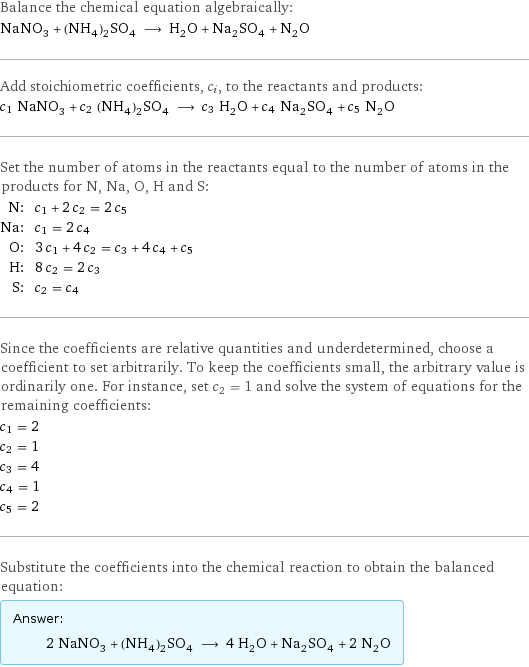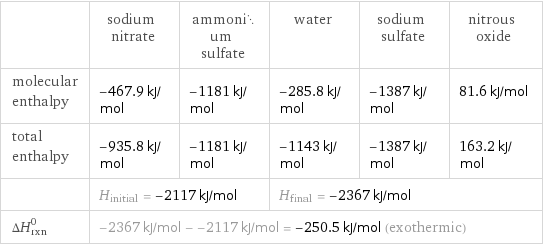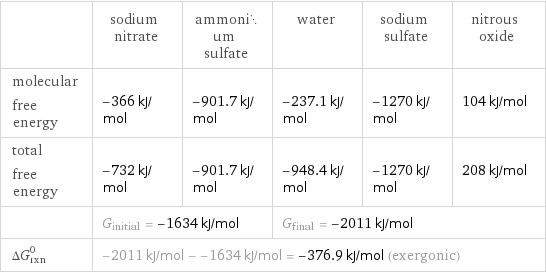Input interpretation

NaNO_3 sodium nitrate + (NH_4)_2SO_4 ammonium sulfate ⟶ H_2O water + Na_2SO_4 sodium sulfate + N_2O nitrous oxide
Balanced equation

Balance the chemical equation algebraically: NaNO_3 + (NH_4)_2SO_4 ⟶ H_2O + Na_2SO_4 + N_2O Add stoichiometric coefficients, c_i, to the reactants and products: c_1 NaNO_3 + c_2 (NH_4)_2SO_4 ⟶ c_3 H_2O + c_4 Na_2SO_4 + c_5 N_2O Set the number of atoms in the reactants equal to the number of atoms in the products for N, Na, O, H and S: N: | c_1 + 2 c_2 = 2 c_5 Na: | c_1 = 2 c_4 O: | 3 c_1 + 4 c_2 = c_3 + 4 c_4 + c_5 H: | 8 c_2 = 2 c_3 S: | c_2 = c_4 Since the coefficients are relative quantities and underdetermined, choose a coefficient to set arbitrarily. To keep the coefficients small, the arbitrary value is ordinarily one. For instance, set c_2 = 1 and solve the system of equations for the remaining coefficients: c_1 = 2 c_2 = 1 c_3 = 4 c_4 = 1 c_5 = 2 Substitute the coefficients into the chemical reaction to obtain the balanced equation: Answer: | | 2 NaNO_3 + (NH_4)_2SO_4 ⟶ 4 H_2O + Na_2SO_4 + 2 N_2O
Structures

+ ⟶ + +
Names

sodium nitrate + ammonium sulfate ⟶ water + sodium sulfate + nitrous oxide
Reaction thermodynamics
Enthalpy

| sodium nitrate | ammonium sulfate | water | sodium sulfate | nitrous oxide molecular enthalpy | -467.9 kJ/mol | -1181 kJ/mol | -285.8 kJ/mol | -1387 kJ/mol | 81.6 kJ/mol total enthalpy | -935.8 kJ/mol | -1181 kJ/mol | -1143 kJ/mol | -1387 kJ/mol | 163.2 kJ/mol | H_initial = -2117 kJ/mol | | H_final = -2367 kJ/mol | | ΔH_rxn^0 | -2367 kJ/mol - -2117 kJ/mol = -250.5 kJ/mol (exothermic) | | | |
Gibbs free energy

| sodium nitrate | ammonium sulfate | water | sodium sulfate | nitrous oxide molecular free energy | -366 kJ/mol | -901.7 kJ/mol | -237.1 kJ/mol | -1270 kJ/mol | 104 kJ/mol total free energy | -732 kJ/mol | -901.7 kJ/mol | -948.4 kJ/mol | -1270 kJ/mol | 208 kJ/mol | G_initial = -1634 kJ/mol | | G_final = -2011 kJ/mol | | ΔG_rxn^0 | -2011 kJ/mol - -1634 kJ/mol = -376.9 kJ/mol (exergonic) | | | |
Equilibrium constant
![Construct the equilibrium constant, K, expression for: NaNO_3 + (NH_4)_2SO_4 ⟶ H_2O + Na_2SO_4 + N_2O Plan: • Balance the chemical equation. • Determine the stoichiometric numbers. • Assemble the activity expression for each chemical species. • Use the activity expressions to build the equilibrium constant expression. Write the balanced chemical equation: 2 NaNO_3 + (NH_4)_2SO_4 ⟶ 4 H_2O + Na_2SO_4 + 2 N_2O Assign stoichiometric numbers, ν_i, using the stoichiometric coefficients, c_i, from the balanced chemical equation in the following manner: ν_i = -c_i for reactants and ν_i = c_i for products: chemical species | c_i | ν_i NaNO_3 | 2 | -2 (NH_4)_2SO_4 | 1 | -1 H_2O | 4 | 4 Na_2SO_4 | 1 | 1 N_2O | 2 | 2 Assemble the activity expressions accounting for the state of matter and ν_i: chemical species | c_i | ν_i | activity expression NaNO_3 | 2 | -2 | ([NaNO3])^(-2) (NH_4)_2SO_4 | 1 | -1 | ([(NH4)2SO4])^(-1) H_2O | 4 | 4 | ([H2O])^4 Na_2SO_4 | 1 | 1 | [Na2SO4] N_2O | 2 | 2 | ([N2O])^2 The equilibrium constant symbol in the concentration basis is: K_c Mulitply the activity expressions to arrive at the K_c expression: Answer: | | K_c = ([NaNO3])^(-2) ([(NH4)2SO4])^(-1) ([H2O])^4 [Na2SO4] ([N2O])^2 = (([H2O])^4 [Na2SO4] ([N2O])^2)/(([NaNO3])^2 [(NH4)2SO4])](../image_source/e84a806573bc98c1d149d756af4a86c9.png)
Construct the equilibrium constant, K, expression for: NaNO_3 + (NH_4)_2SO_4 ⟶ H_2O + Na_2SO_4 + N_2O Plan: • Balance the chemical equation. • Determine the stoichiometric numbers. • Assemble the activity expression for each chemical species. • Use the activity expressions to build the equilibrium constant expression. Write the balanced chemical equation: 2 NaNO_3 + (NH_4)_2SO_4 ⟶ 4 H_2O + Na_2SO_4 + 2 N_2O Assign stoichiometric numbers, ν_i, using the stoichiometric coefficients, c_i, from the balanced chemical equation in the following manner: ν_i = -c_i for reactants and ν_i = c_i for products: chemical species | c_i | ν_i NaNO_3 | 2 | -2 (NH_4)_2SO_4 | 1 | -1 H_2O | 4 | 4 Na_2SO_4 | 1 | 1 N_2O | 2 | 2 Assemble the activity expressions accounting for the state of matter and ν_i: chemical species | c_i | ν_i | activity expression NaNO_3 | 2 | -2 | ([NaNO3])^(-2) (NH_4)_2SO_4 | 1 | -1 | ([(NH4)2SO4])^(-1) H_2O | 4 | 4 | ([H2O])^4 Na_2SO_4 | 1 | 1 | [Na2SO4] N_2O | 2 | 2 | ([N2O])^2 The equilibrium constant symbol in the concentration basis is: K_c Mulitply the activity expressions to arrive at the K_c expression: Answer: | | K_c = ([NaNO3])^(-2) ([(NH4)2SO4])^(-1) ([H2O])^4 [Na2SO4] ([N2O])^2 = (([H2O])^4 [Na2SO4] ([N2O])^2)/(([NaNO3])^2 [(NH4)2SO4])
Rate of reaction
![Construct the rate of reaction expression for: NaNO_3 + (NH_4)_2SO_4 ⟶ H_2O + Na_2SO_4 + N_2O Plan: • Balance the chemical equation. • Determine the stoichiometric numbers. • Assemble the rate term for each chemical species. • Write the rate of reaction expression. Write the balanced chemical equation: 2 NaNO_3 + (NH_4)_2SO_4 ⟶ 4 H_2O + Na_2SO_4 + 2 N_2O Assign stoichiometric numbers, ν_i, using the stoichiometric coefficients, c_i, from the balanced chemical equation in the following manner: ν_i = -c_i for reactants and ν_i = c_i for products: chemical species | c_i | ν_i NaNO_3 | 2 | -2 (NH_4)_2SO_4 | 1 | -1 H_2O | 4 | 4 Na_2SO_4 | 1 | 1 N_2O | 2 | 2 The rate term for each chemical species, B_i, is 1/ν_i(Δ[B_i])/(Δt) where [B_i] is the amount concentration and t is time: chemical species | c_i | ν_i | rate term NaNO_3 | 2 | -2 | -1/2 (Δ[NaNO3])/(Δt) (NH_4)_2SO_4 | 1 | -1 | -(Δ[(NH4)2SO4])/(Δt) H_2O | 4 | 4 | 1/4 (Δ[H2O])/(Δt) Na_2SO_4 | 1 | 1 | (Δ[Na2SO4])/(Δt) N_2O | 2 | 2 | 1/2 (Δ[N2O])/(Δt) (for infinitesimal rate of change, replace Δ with d) Set the rate terms equal to each other to arrive at the rate expression: Answer: | | rate = -1/2 (Δ[NaNO3])/(Δt) = -(Δ[(NH4)2SO4])/(Δt) = 1/4 (Δ[H2O])/(Δt) = (Δ[Na2SO4])/(Δt) = 1/2 (Δ[N2O])/(Δt) (assuming constant volume and no accumulation of intermediates or side products)](../image_source/4e72a298be03fee1be47ed9c50020994.png)
Construct the rate of reaction expression for: NaNO_3 + (NH_4)_2SO_4 ⟶ H_2O + Na_2SO_4 + N_2O Plan: • Balance the chemical equation. • Determine the stoichiometric numbers. • Assemble the rate term for each chemical species. • Write the rate of reaction expression. Write the balanced chemical equation: 2 NaNO_3 + (NH_4)_2SO_4 ⟶ 4 H_2O + Na_2SO_4 + 2 N_2O Assign stoichiometric numbers, ν_i, using the stoichiometric coefficients, c_i, from the balanced chemical equation in the following manner: ν_i = -c_i for reactants and ν_i = c_i for products: chemical species | c_i | ν_i NaNO_3 | 2 | -2 (NH_4)_2SO_4 | 1 | -1 H_2O | 4 | 4 Na_2SO_4 | 1 | 1 N_2O | 2 | 2 The rate term for each chemical species, B_i, is 1/ν_i(Δ[B_i])/(Δt) where [B_i] is the amount concentration and t is time: chemical species | c_i | ν_i | rate term NaNO_3 | 2 | -2 | -1/2 (Δ[NaNO3])/(Δt) (NH_4)_2SO_4 | 1 | -1 | -(Δ[(NH4)2SO4])/(Δt) H_2O | 4 | 4 | 1/4 (Δ[H2O])/(Δt) Na_2SO_4 | 1 | 1 | (Δ[Na2SO4])/(Δt) N_2O | 2 | 2 | 1/2 (Δ[N2O])/(Δt) (for infinitesimal rate of change, replace Δ with d) Set the rate terms equal to each other to arrive at the rate expression: Answer: | | rate = -1/2 (Δ[NaNO3])/(Δt) = -(Δ[(NH4)2SO4])/(Δt) = 1/4 (Δ[H2O])/(Δt) = (Δ[Na2SO4])/(Δt) = 1/2 (Δ[N2O])/(Δt) (assuming constant volume and no accumulation of intermediates or side products)
Chemical names and formulas

| sodium nitrate | ammonium sulfate | water | sodium sulfate | nitrous oxide formula | NaNO_3 | (NH_4)_2SO_4 | H_2O | Na_2SO_4 | N_2O Hill formula | NNaO_3 | H_8N_2O_4S | H_2O | Na_2O_4S | N_2O name | sodium nitrate | ammonium sulfate | water | sodium sulfate | nitrous oxide IUPAC name | sodium nitrate | | water | disodium sulfate | nitrous oxide